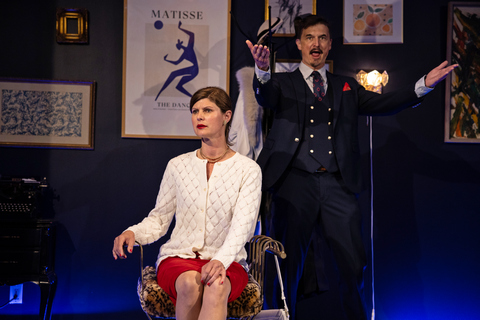La Musica Deuxième
A rare outing for the revised version of a classic play by French playwright and novelist Marguerite Duras.

Matilda Woods and Taylor “TV” Valentine in a scene from Marguerite Duras’ “La Musica Deuxième” at the Drawing Room (Photo credit: Maria Baranova)
[avatar user=”Victor Gluck” size=”96″ align=”left”] Victor Gluck, Editor-in-Chief[/avatar]
Jessica Burr’s Blessed Unrest production of Marguerite Duras’ La Musica Deuxième in the 1992 translation by Barbara Bray is like a violent Jean-Paul Sartre short story directed in the cool style of filmmaker Éric Rohmer. Whether this is best for the material, you will have to decide for yourself. Aside from the 2023 film of Duras’ play Suzanna Andler, this is the first New York presentation of one of her plays since Savannah Bay at the Classic Stage Company in 2003.
Duras’ plays tend to be two character conversations in which the people involved review a fraught past relationship. There tends not be any physical violence but the words suggest tremendous passion. La Musica Deuxième is an expanded version of the shorter one-act La Musica written 20 years before. In both plays a couple Michel Nollet and Anne-Marie Roche (who has gone back to her maiden name) meet for one last time on the eve of their divorce decree becoming finalized at the provincial hotel where they lived happily before their house had been finished at the beginning of their marriage.

They review what they have done since they last saw each other almost four years before. Each is about to remarry when the divorce is legal. He had continued his career as an architect while she has gone back to being a translator. Then they delve into the betrayals of their final years together. It is as though they are exploring if they can live together or must live apart.
Nollet reveals that when he discovered that Anne Marie was unfaithful he went out to kill, while she tells him for the first time she had tried suicide after they parted. They each explain their actions in the final days before their parting. He is still bitter and angry (though he misses her greatly) and suddenly attempts to strangle her. In this version of the play, they occasionally talk directly to the audience consciously breaking the fourth wall, and at one point Anne Marie travels down the middle aisle to the back of the small seating space for the audience. Music (Beethoven’s Sonata No. 2 for piano and violoncello in G minor punctuates the action at various moments and at one point they begin to dance to Duke Ellington’s “Black and Tan Fantasy,” in the 1945 version.

Matilda Woods and Taylor “TV” Valentine in a scene from Marguerite Duras’ “La Musica Deuxième” at the Drawing Room (Photo credit: Maria Baranova)
Aside from allowing the actors to use a very mannered style of acting, though the text is rather arch, Burr has translated Nollet’s two phone calls from his girlfriend in Paris into French which makes it difficult for those who don’t know the language. Although we only hear one side of the conversation, a good deal of important information is discussed. As She, Matilda Woods is cool and serene, as though she is completely finished with this marriage and this ex-husband. She behaves as though she has a dark secret but what she reveals is not what we were expecting. Taylor “TV” Valentine’s He is more emotional and nuanced as the seemingly more injured party. Both are somewhat artificial in the French style. However, one wonders how Delphine Seyrig and Robert Hossein played the roles in the rarely shown 1966 film co-directed by Duras herself or how Isabelle Huppert and Pascal Greggory would do them in a remake today.
The uncredited set design with its armchairs, étagères, lamps, rugs and potted plant create a suitable space for the lobby of the provincial hotel. While Sera Bourgeau’s costumes are chic, Woods’ attractive red dress seems a little too loud for this seemingly retiring person. Valentine’s three piece navy blue suit suggests the play is taking place a while ago. The lighting by Jay Ryan though adequate fails to create any mood. In addition, the light coming through the uncovered side windows to the theater is distracting since the play is set at midnight. Laura Galindo’s sound design includes the telephone rings and the musical interludes which at times creep up in a low volume and at others are very obvious.

Taylor “TV” Valentine and Matilda Woods in a scene from Marguerite Duras’ “La Musica Deuxième” at the Drawing Room (Photo credit: Maria Baranova)
While Marguerite Duras is a major French playwright, she is rarely presented here and this may be the first New York performances of La Musica Deuxième. Though this is not a definitive production, it does demonstrate the potential of this play to intrigue. The play which evolves like a mystery is always interesting as the two characters reveal themselves to us and each other.
La Musica Deuxième (May 2 – 18, 2024)
Drawing Room, 247 West 30th Street, in Manhattan
For tickets, visits http://www.blessedunrest.org
Running time: one hour and 35 minutes without an intermission






Leave a comment